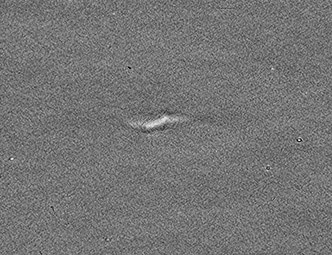


Results from poor coalescence of atomized paint droplets. Orange PeelĬondition : Uneven Surface Formation – much like the physical appearance of orange peel. Contamination of air lines : Check for oil in air lines and spray equipment.Usually solvent wiping will not remove embedded silicone. Effects of the old finish or previous repair : Old finish or previous repair may contain excessive amounts of silicone from additives used during their application.– Check airborne contamination in spray area. – Check for proper cleaning procedures prior to refinishing. – Check for any oils or contamination that might get into the spray area.
#Fisheye paint defect skin#
– Check for painter contamination, skin oils, perspiration, greasy foods, etc.

Even small quantities in sanding dust, rags or from cars being polished nearby can cause this failure.- Check for possible contamination in paint materials. Small traces of silicone do not allow paint to settle evenly rather they cause material to encircle the speck of silicone and form a fish’s eye. Silicone adheres firmly to the paint film and requires extra effort for its removal. Many waxes and polishes contain silicone, the most common cause of fish eyes.
Causes Improper Surface Cleaning Or Preparation. Solvent Popping – Blisters on the paint surface caused by trapped solvents in the topcoats or primer.įish EyesĬondition : Tiny surface finish blemishes that resemble small circles of popped paint bubbles, which seem to occur almost as soon as paint hits an auto body surface. Sand Scratches – Sanding pattern imperfections that show through the finished paint film. Paint Runs and Sags – Heavy application of sprayed material failing to adhere uniformly to the surface. Paint Color Matching – Finished panels that don’t match the color of standard panels. Orange Peel – Uneven Surface Formation – with an orange peel texture. Fish Eyes – Tiny surface finish blemishes that resemble small circles of popped paint bubbles, of fish eye appearance. Dry Spray – A rough, textured surface often confined to a small area. Dirt – Small bumps deposited in, on, or under the paint film.  Die Back – Loss of gloss after application. Bleeding – Original finish discoloring or color seeping through the new topcoat color. If you plan on spending a day or two just to prepare your car’s body surface for paint, the need for auto paint repair won’t be necessary. They believe that a thick coat of paint will hide blemishes or flaws, it simply won’t.ĭon’t rush into things. Too many times, enthusiastic rookie painters get ahead of themselves. We always heartily recommend anybody to spend an adequate amount of time preparing their vehicle’s surface for paint and therefore minimize the need for car paint repair afterwards. This format details the condition of the problem, it’s causes, prevention and the best solution. On this page you will find a treatment of the most common paint finish problems. If auto painting is a new venture for you, it is imperative that you understand the basics of do it yourself auto body paint repair. Check out the LABAP VIP course that will help turn you into an auto body and paint pro, from home! Top 10 Auto Paint Repair Problems and Solutions
Die Back – Loss of gloss after application. Bleeding – Original finish discoloring or color seeping through the new topcoat color. If you plan on spending a day or two just to prepare your car’s body surface for paint, the need for auto paint repair won’t be necessary. They believe that a thick coat of paint will hide blemishes or flaws, it simply won’t.ĭon’t rush into things. Too many times, enthusiastic rookie painters get ahead of themselves. We always heartily recommend anybody to spend an adequate amount of time preparing their vehicle’s surface for paint and therefore minimize the need for car paint repair afterwards. This format details the condition of the problem, it’s causes, prevention and the best solution. On this page you will find a treatment of the most common paint finish problems. If auto painting is a new venture for you, it is imperative that you understand the basics of do it yourself auto body paint repair. Check out the LABAP VIP course that will help turn you into an auto body and paint pro, from home! Top 10 Auto Paint Repair Problems and Solutions








 0 kommentar(er)
0 kommentar(er)
